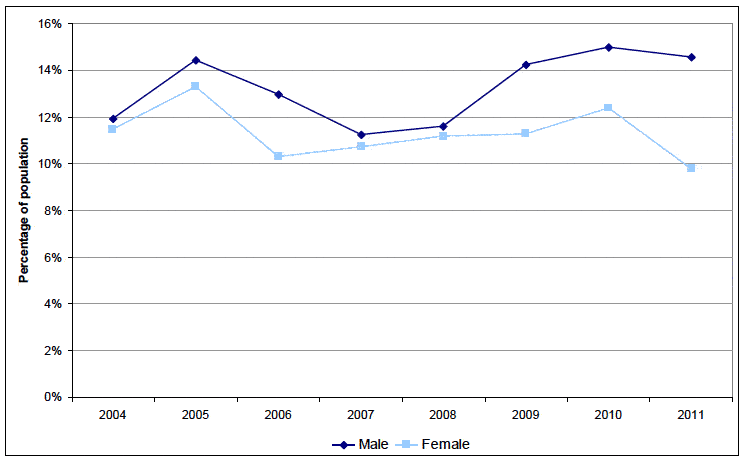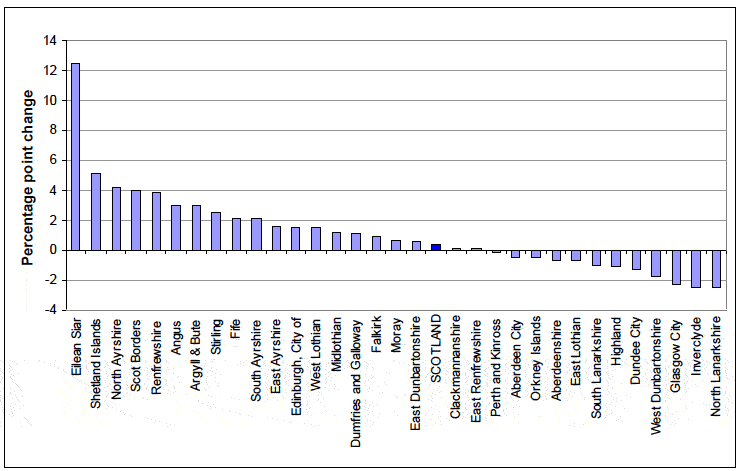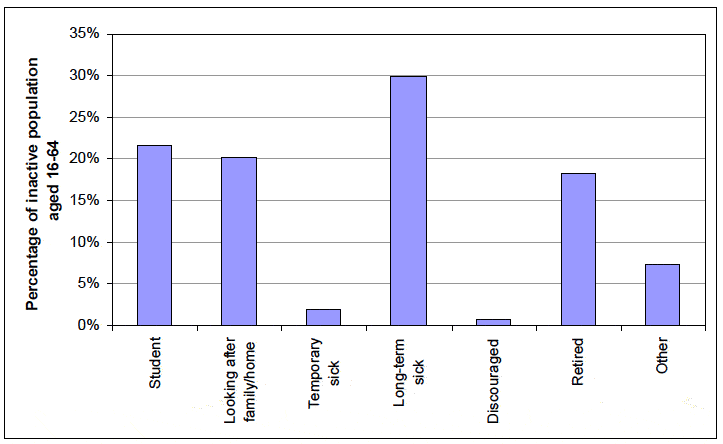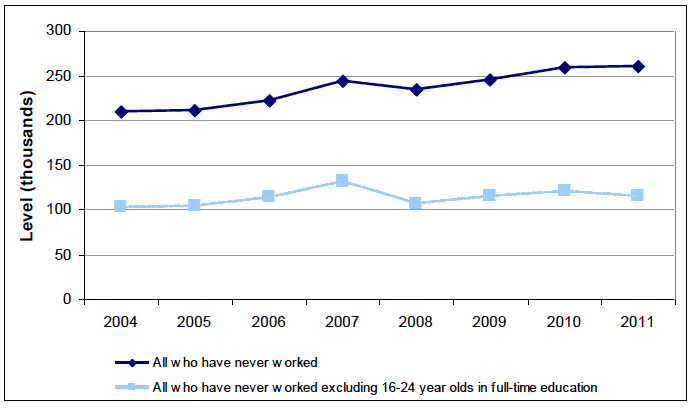Local Area Labour Markets in Scotland - Statistics from the Annual Population Survey 2011
Summary publication of results from the Annual Population Survey 2011, presenting analysis on the labour market, education and training. Results are provided for Scotland and local authority areas in Scotland.
Section 2: People not in work
This section examines those who are not in employment. As model based estimates for unemployment will not be published by ONS until 18 July 2012, this section will focus primarily on the economically inactive, with unemployment being covered in more depth in July's Labour Market Brief [4].
16 to 19 year olds Not in Education, Employment or Training (NEET)
In 2011, the Annual Population Survey (APS) estimated that there were 31,000 young people aged 16 to 19 not in education, employment or training, representing 12.2% of all 16 to 19 year olds.
Figure 1 - Percentage and level of 16 to 19 year olds NEET, Scotland, 2004-2011
| Year | Male | Female | All | |||
|---|---|---|---|---|---|---|
| Percentage | Level | Percentage | Level | Percentage | Level | |
| 2004 | 11.9% | 16,000 | 11.5% | 15,000 | 11.7% | 31,000 |
| 2005 | 14.4% | 19,000 | 13.3% | 17,000 | 13.9% | 36,000 |
| 2006 | 13.0% | 17,000 | 10.3% | 13,000 | 11.7% | 30,000 |
| 2007 | 11.3% | 15,000 | 10.7% | 14,000 | 11.0% | 29,000 |
| 2008 | 11.6% | 16,000 | 11.2% | 14,000 | 11.4% | 30,000 |
| 2009 | 14.2% | 19,000 | 11.3% | 14,000 | 12.8% | 33,000 |
| 2010 | 15.0% | 20,000 | 12.4% | 16,000 | 13.7% | 36,000 |
| 2011 | 14.6% | 19,000 | 9.8% | 12,000 | 12.2% | 31,000 |
Source: Annual Population Survey, Jan-Dec
Figure 1 shows how the NEET group has changed in Scotland between 2004 and 2011. Over the past year the NEET level decreased by 5,000
(1.5 percentage points), however, this change is not statistically significant.
Between 2005 and 2007 there was a significant reduction in the size of the NEET group, a decrease of 7,000 (2.9 percentage points). This was followed by a significant increase between 2007 and 2010, an increase of 7,000 (2.7 percentage points).
Generally more males aged 16 to 19 are NEET than females, however, from 2004 to 2010 the gap was not statistically significant. In 2011 there was a statistically significant gap between the percentage of males and females who were NEET, due to the decrease in 16-19 year old females who were NEET.
Chart 9 - Percentage of 16-19 year olds NEET by gender, Scotland, 2004-2011

Source: Annual Population Survey, Jan-Dec, ONS
| Box 4 - Measuring the NEET group |
|---|
In 2006 the Scottish Government commissioned the Training and Employment Research Unit (TERU) at Glasgow University to explore different ways of measuring the NEET group and present recommendations on the best measurement options. The following recommendations were made: At Scotland level: The Annual Population Survey (APS) is the recommended source to measure the size of the NEET group in Scotland. At Local Authority level: A combination of DWP benefits data and school leavers destinations data should be used to monitor the NEET group at a local level. Information on levels and rates of known NEET at local authority level for 2004 to 2010 can be accessed at: The full report outlining the work and recommendations made by TERU can be found at: Recent developments Historically, it has been difficult to make robust conclusions when comparing proportions of young people NEET internationally, due to differing definitions of NEET. The Scottish Government is working closely with ONS and the other UK administrations to agree a measure of NEET which will allow meaningful and consistent international comparisons to be made between UK countries in the future. At present we have agreed a consistent methodology for defining whether a young person is NEET and this methodology has been adopted for this publication. Although this methodology uses a different combination of LFS/APS variables compared to the methodology used in previous years by the Scottish Government, the results are broadly similar. The ONS is currently working towards publishing NEET indicators in the main labour market bulletin and the Scottish Government will make relevant analysis for Scotland available where possible. The Scottish Government will continue to focus on 16-19 year olds in its own publications due to the fact that this is the age group at which policy interventions are targeted at present. |
Economic Inactivity
Economic inactivity covers individuals who are neither in employment nor unemployed. There are many reasons why people may be inactive. For example, they may have a long-term illness or disability, be studying for a qualification, staying at home to look after their family, or have retired. The economically inactive population are not part of the supply of labour. However, the labour market is dynamic, with people continuously moving between different categories. Therefore it is important to consider inactivity figures as they include those who may make up the labour supply in the future and those who were part of the labour supply in the past.
| Box 5 - Economic Inactivity |
|---|
Economically inactive people are not in employment, but do not satisfy the internationally agreed definition of unemployment. This group covers people without a job who:
Headline Inactivity levels and rates cover all workers aged 16-64 for both men and women. This excludes many people who would be inactive due to retirement, although still captures a large number of people in early retirement. |
Over the year to January to December 2011, the economic inactivity rate for those aged 16-64 in Scotland remained unchanged at 23.0% (up 2,300 to 783,500), but increased by 0.4 percentage points since 2008 (up 19,300), driven by a 0.8 percentage point increase in the inactivity rate for men.
Local Authority Analysis
Between 2010 and 2011, the economic inactivity rate decreased in just under half (14) of Scotland's local authorities, one saw no change, while the remaining 17 authorities saw increases in their rate. The largest decreases were seen in Orkney Islands, West Dunbartonshire, City of Edinburgh and the Scottish Borders while the largest increases were seen in Clackmannanshire, Shetland Islands and East Ayrshire.
Since 2008, the economic inactivity rate has increased in the majority (20) of Scotland's local authorities, with the remaining 12 authorities seeing decreases. As all local authorities saw decreases in their employment rates during the same period, those areas which saw a decrease in their inactivity rates are likely to have seen a general shift in their working age populations from employment and inactivity into unemployment. However, the picture is not consistent across genders. Over one third of all authorities have seen increases in both their male and female inactivity rates, with Eilean Siar, North Ayrshire, Scottish Borders and Renfrewshire seeing amongst the highest increases, while five authorities; Inverclyde, North Lanarkshire, Dundee, Glasgow and West Dunbartonshire; all saw decreases in the inactivity rates for both males and females.
Table 6 in Annex A shows the inactivity rates by local authority for 2008, 2010 and 2011 for people aged 16-64. A full time series back to 2004 is available in the web-tables and from SNS. The relationship between unemployment rates and inactivity rates is complex. The higher the level of inactivity within an area, the lower the level of economic activity (the sum of employment and unemployment). The unemployment rate is calculated using the number of economically active people as a denominator; consequently in areas where there are high levels of inactivity the unemployment rate is also higher. Data from 2004 to 2011 is available in the web tables and via Scottish Neighbourhood Statistics.
Chart 10 - Inactivity rate for people aged 16-64 by local authority, Scotland, Change from 2008 to 2011

Source: Annual Population Survey, Jan-Dec, ONS
Reasons for inactivity
Respondents in the APS are asked to provide a reason as to why they are not in employment or unemployed. Chart 11 shows the breakdown of reasons for inactivity for 2011 in Scotland.
Chart 11 - Reasons for inactivity, Scotland, 2011

Source: Annual Population Survey, Jan-Dec, ONS
The largest group within the economically inactive population is those stating they have a long-term sickness or disability. The relative size of this group had reduced slowly from 33.0% in 2004 to just under 29.0% in 2009, but has levelled of at around 30.0% since.
- East Ayrshire, Falkirk, Glasgow, Inverclyde, North Ayrshire, North Lanarkshire and West Dunbartonshire had the highest percentages of inactive population stating they are long-term sick in 2011, all greater than 35%.
Those looking after the family or home make up just over a fifth (20.2%) of the inactive population, having fallen slightly (1.2 percentage points) from 21.7% in 2008.
- Aberdeenshire, Argyll & Bute and West Lothian had the highest percentages of those inactive due to looking after family or home, at 24.0% or more.
Students are one of the other main inactive groups, accounting for 21.6% of the inactive population in 2011. The relative size of this group had grown from 17.3% in 2004 to 21.6% in 2010, and has since stabilised around this level. The overall size of this group has increased by 26.9%, from 133,200 in 2004, to 169,000 in 2011.
- Only nine authorities had a higher percentage of students in their inactive population than the national average in 2011. These include the main university cities (Aberdeen, Dundee, Edinburgh, Glasgow and Stirling), as well as East Dunbartonshire, East Renfrewshire, Scottish Borders and Eilean Siar.
Retired people accounted for 18.3% of the inactive population aged 16-64 in Scotland in 2011.
- 18 local authorities had higher percentages of retired inactive people than the national average. Those with the highest percentages include Argyll & Bute, Clackmannanshire, East Dunbartonshire, Moray, Perth and Kinross, Scottish Borders, and South Ayrshire (which all have populations that have higher percentages of older people). In contrast, Glasgow and Edinburgh have the lowest percentages of inactive retired people, a reflection of the different age demographic within these local authorities.
More detailed information on reasons for inactivity by local authority is provided in the web tables.
Willingness to work
People who are inactive may have a willingness to work but are not available or able to do so. In 2011, 24.6% of all people in Scotland aged 16-64 who were inactive, wanted to work, compared to 24.1% in 2010. The percentage was highest in Moray, West Lothian and Falkirk, where the percentage of inactive people said they would like to work was 42.8%, 31.9% and 30.4% respectively. Table 7 shows the number and percentage of those who are inactive but want to work.
Adults who have never worked.
The APS asks those who did no paid or unpaid work if they have ever had a paid job or place on a government training scheme. As many younger people do not enter the labour market until after leaving full-time education, the chances of a person having ever worked[5] is highly dependant on their age. Chart 12 shows how the level of those who have never had a paid or unpaid job has changed between 2004 and 2011. The number of people aged 16 and over in Scotland who have never worked has been gradually increasing since 2004, however over the year to 2011, the level has remained almost static around 259,700. The level has increased by just under 11% since 2008 (234,500) and by just under a quarter since 2004 (209,000). However, approximately half of these people are 16-24 year olds in full-time education. If this group is excluded, the figure for 2011 decreases to 114,700, which represents a 5% decrease on the 2010 level and a 12% increase on the 2004 level (102,800).
Chart 12 - Number of people aged 16 and over who have never worked, Scotland, 2004 - 2011

Source: Annual Population Survey, Jan-Dec, ONS
The number of people aged 25-49 in Scotland who have never worked has risen by just under 54% since 2004, from 33,500 to 51,600 in 2011, whereas the number of people aged 50 and over who have never worked has decreased by just under 33% from 32,900 in 2004 to 22,100 in 2011.
Reasons people may never have had a paid or unpaid job include being a student (in full-time education), looking after family or home and being long-term sick or disabled
Since 2008, the number of people aged 16 and over who have never had a paid or unpaid job has increased in 22 of Scotland's local authorities. Data for those who have never worked at local authority level is available from the web tables and via Scottish Neighbourhood Statistics.
Contact
Email: Alan Winetrobe
There is a problem
Thanks for your feedback